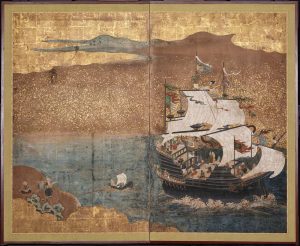Core Program 2018–19
- Browse list of Core Programs, 1991–.
2018–19
Making Worlds: Art, Materiality, and Early Modern Globalization
—organized by Bronwen Wilson, University of California, Los Angeles, and Angela Vanhaelen, McGill University
co-sponsored by the Social Sciences and Humanities Research Council of Canada (SSHRC) Insight Grant

Narratives of colonialism, empire building, and religious mission—of center, periphery, and globalization—have been under revision in recent years in order to nuance our understanding of what were immensely complex and multi-faceted phenomena. This year’s conference series will shift the focus from governing regimes and institutions to ways in which creative forms and practices were intertwined in the dynamics of materiality and early modern globalism. Such a proposition directs analysis toward the flow of materials, artifacts, and motifs across borders and bodies of water. It attends to experimentation that activated and responded to this traffic in things; it investigates these interactions as constant, on-going processes, thereby bringing innovation, ornamentation, improvisation, and sensation to the fore.
Such interactions were given impetus by an efflorescence of cosmopolitan spaces in the seventeenth and eighteenth centuries. These are cities, ports, exhibition sites, ships, caravanserais, markets, museums, theaters, and warehouses. They are spaces that are open to becoming something new, provisional instead of fixed in their form; they are not inherently hierarchical nor merely commercial, but inflected by global relations of power; they are spaces in which distance and presence are brought into consideration with each other. They are spaces through which people of diverse ethnicities, faiths, and vocational interests came and went. Allowing for convergences, reorientations, and interconnections, cosmopolitan spaces propelled people and artefacts in unexpected directions, giving rise to new ways of thinking.
These interconnected themes of spaces, materials, and imagination will be examined in three conferences through developing a series of interrelated case studies of movement and migration. These sessions will foster discussion and debate with visiting and local researchers and with the Making Worlds research project (https://www.makinggreenworlds.net/making-worlds).
Conference 1: In Between Spaces
October 12-13, 2018
This first conference will consider movement, migration, and invention through, between, and within early modern spaces. The papers will explore new uses for, practices in, and configurations of spaces such as inns, ships, caravans, islands, warehouses, deserts, streets, and waterways. Such spaces could be in motion or transitional, both isolated and connected, and open to unpredictable forms of traffic. These spaces have much to teach us about flows and commingling of materials, media, motifs, practices, and people across and between cultures in the early modern world.
Conference 2: Material Flows
February 1-2, 2019
This conference will consider the flows, circuitry, and transformations of materials, motifs, styles, artistic vocabularies, and practices across geographical boundaries. Recent considerations of transnational studies and the global turn have prompted a shift away from area studies, state formation, and fixed borders to take into account concepts such as mobility and cultural entanglement. Papers will take up artefacts and motifs, tracing their circuitry and their paths to explore the implications of global movement and material flows.
Conference 3: Other Worlds
May 3-4, 2019
Having examined the potential for creative interaction to which “in between spaces” and “material flows” across geographies gave rise, this conference turns to “other worlds.” These are imaginary places, such as utopias and paradises; sites, like Jerusalem, that have been recreated elsewhere; travel narratives; costumes, performances, and ballets, such as Ben Jonson’s Masque of Blackness (1605) and Daniel Rabel’s designs for Americans for René Bordier’s Ballet de la Douairière de Billebahaut (1626); and representations of terrestrial and astronomical imagery. Papers will consider ways in which literary, theatrical, theological, mythological, architectural, and geographical forms became loci for imagining and inventing other worlds.

